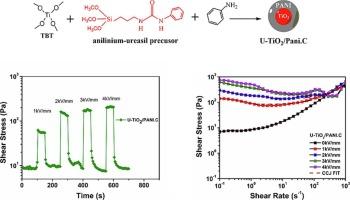Synthesis, characterization and electrorheological performance of polyaniline/organically modified titanium oxide hybrids
IF 5.2
2区 化学
Q2 CHEMISTRY, PHYSICAL
引用次数: 0
Abstract
A novel approach for synthesizing hybrid materials comprising polyaniline (PAni) and titanium dioxide (TiO₂) has been developed using ureasil-modified TiO2 (U-TiO₂). Two distinct synthesis methods were explored, targeting at application in electrorheological (ER) fluids. The resulting hybrid particles were characterized using a comprehensive range of techniques, including thermal, structural, morphological, spectroscopic, and electrical analyses. ER fluids were formulated by dispersing the particles in silicone oil, and their rheological and dielectric behaviors were systematically evaluated. Among the methods studied, the in situ polymerization of aniline within a sol–gel emulsion containing U-TiO₂, without isolating the intermediate particles, yielded the U-TiO₂/PAni.C with superior results, including a maximum yield stress of 844 Pa under an applied electric field of 4 kV/mm. The ER fluids demonstrated excellent reversibility during repeated on–off electric field switching tests, highlighting their potential for practical applications. Comparative analysis with existing literature revealed that ER performance was significantly influenced by the concentrations of PAni and TiO₂, as well as particle morphology. Notably, the U-TiO₂/PAni.C hybrid developed in this study outperformed other reported PAni–TiO₂ systems, emphasizing its strong promise for advanced ER fluid applications. The great novelty of this research was the development of a high-performance, ureasil-modified TiO₂/polyaniline hybrid via an in situ polymerization route, resulting in unprecedented ER fluid performance, enhanced reversibility, and potential scalability.

聚苯胺/有机改性氧化钛杂化材料的合成、表征及电流变特性研究
利用脲醇修饰的TiO2 (U-TiO 2)合成了聚苯胺(PAni)和二氧化钛(TiO 2)的杂化材料。探索了两种不同的合成方法,旨在应用于电流变(ER)流体。所得到的杂化颗粒使用了广泛的技术进行表征,包括热、结构、形态、光谱和电分析。将颗粒分散在硅油中配制成ER流体,并对其流变性能和介电性能进行了系统评价。在所研究的方法中,苯胺在含有U-TiO 2的溶胶-凝胶乳液中原位聚合,不分离中间颗粒,得到了U-TiO 2 /PAni.C,其结果非常好,在4 kV/mm的电场下,最大屈服应力为844 Pa。在反复的电场开关测试中,ER流体表现出优异的可逆性,突出了它们的实际应用潜力。通过与已有文献的对比分析发现,聚苯胺和TiO 2的浓度以及颗粒形态对ER性能有显著影响。值得注意的是,本研究中开发的U-TiO 2 /PAni.C混合体系优于其他已报道的PAni-TiO 2体系,强调了其在先进ER流体应用中的强大前景。这项研究的最大创新之处在于,通过原位聚合途径开发了一种高性能的脲醇修饰的TiO 2 /聚苯胺杂化物,从而获得了前所未有的ER流体性能、增强的可逆性和潜在的可扩展性。
本文章由计算机程序翻译,如有差异,请以英文原文为准。
求助全文
约1分钟内获得全文
求助全文
来源期刊

Journal of Molecular Liquids
化学-物理:原子、分子和化学物理
CiteScore
10.30
自引率
16.70%
发文量
2597
审稿时长
78 days
期刊介绍:
The journal includes papers in the following areas:
– Simple organic liquids and mixtures
– Ionic liquids
– Surfactant solutions (including micelles and vesicles) and liquid interfaces
– Colloidal solutions and nanoparticles
– Thermotropic and lyotropic liquid crystals
– Ferrofluids
– Water, aqueous solutions and other hydrogen-bonded liquids
– Lubricants, polymer solutions and melts
– Molten metals and salts
– Phase transitions and critical phenomena in liquids and confined fluids
– Self assembly in complex liquids.– Biomolecules in solution
The emphasis is on the molecular (or microscopic) understanding of particular liquids or liquid systems, especially concerning structure, dynamics and intermolecular forces. The experimental techniques used may include:
– Conventional spectroscopy (mid-IR and far-IR, Raman, NMR, etc.)
– Non-linear optics and time resolved spectroscopy (psec, fsec, asec, ISRS, etc.)
– Light scattering (Rayleigh, Brillouin, PCS, etc.)
– Dielectric relaxation
– X-ray and neutron scattering and diffraction.
Experimental studies, computer simulations (MD or MC) and analytical theory will be considered for publication; papers just reporting experimental results that do not contribute to the understanding of the fundamentals of molecular and ionic liquids will not be accepted. Only papers of a non-routine nature and advancing the field will be considered for publication.
 求助内容:
求助内容: 应助结果提醒方式:
应助结果提醒方式:


